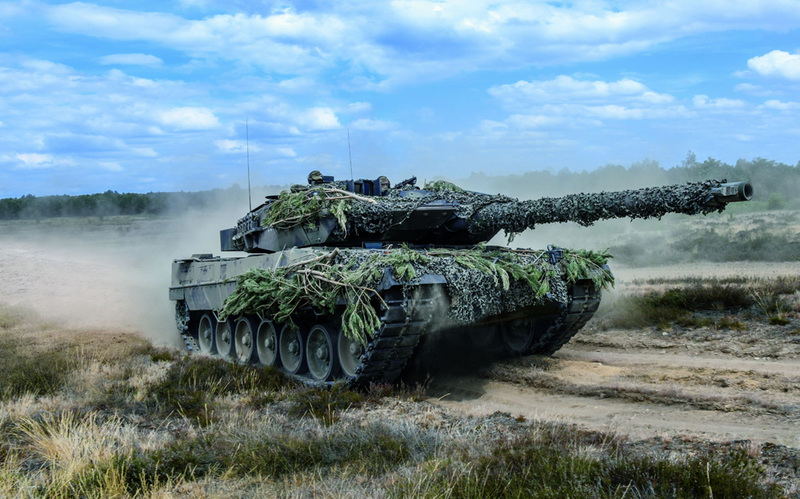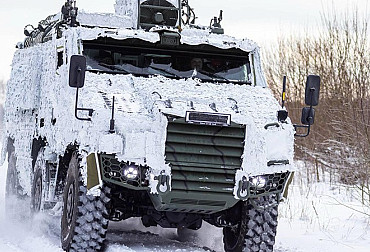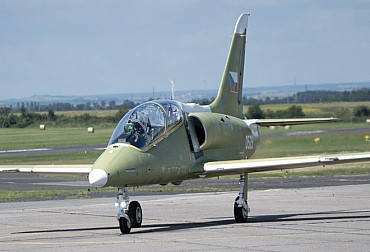Gen. Ivo Střecha: it is essential to find an effective synergy between cutting-edge and less developed technology to achieve the desired effect on the battlefield
Major General Ivo Střecha recently became the first Deputy Chief of the General Staff, replacing Lieutenant General Jaromír Zúna. Gen. Střecha previously served as the Director of the Force Development Section of the Ministry of Defence and in this capacity he was involved in, among other things, modernisation of the Czech Armed Forces and major acquisition projects. In connection with his previous and current position, we asked the General for an interview.
Picture: Major General Ivo Střecha | Ministry of Defence of the Czech Republic
Have the priorities in the armament of the Czech Armed Forces changed in the context of the war in Ukraine, and how will this affect the Concept for the Build-up of the Army of the Czech Republic 2030, the Long-Term Outlook for Defence 2030 or the Strategy for Armaments and Support for the Development of the Defence Industry of the Czech Republic until 2030? What is the timeframe for assessing any new needs of the Czech Armed Forces in the wake of events in Ukraine?
The arming of the Army is determined by fundamental documents such as the Security and Defence Strategy of the Czech Republic. Other documents are the Long-Term Outlook for the Defence of the Czech Republic until 2035, the Concept for the Build-up of the Czech Armed Forces 2030 and related lower-order concepts. These already specify the necessary armament projects. All these documents respond to the new security situation. And it is not new because of the current "hot conflict" in Ukraine, but has been different since the events in Georgia and Crimea. The priorities of the army remain essentially the same and it is only a question of the available resources allocated to the Ministry of Defence how quickly these plans and the priorities set out in them will be implemented. The system of periodic review of the aforementioned documents is set up and responds to all threats and risks to which the security of the Czech Republic may be exposed. That is, not only the risk of conventional war. Experience from any conflict is analysed and implemented in the conceptual documents.
Don't all current plans and concepts rely too much on the capabilities of 21st century technologies, when the current war in Ukraine shows a rather effective use of a combination of "traditional" technology with 21st century technology?
Technology has always played an important role in any conflict. However, finding an effective synergy between cutting edge and less developed technology to achieve the desired effect on the battlefield is absolutely critical. To explain, even the current conflict in Ukraine shows that cutting-edge technology can have an immediate impact on sub-phases of an operation, but in the longer term this advantage can be overwhelmed by the actions of the other side. The key then is the readiness of personnel, commanders and staffs to use them.
In your opinion, will the current or future acquisitions for the Czech Armed Forces be affected by the increased demand for armaments by many European armies? For example, according to information from the Israeli manufacturer of anti-tank guided missiles Spike, in recent months it has been declared that delivery is possible in up to 2 years.
It certainly is. In the past, many of the elementary needs for conventional warfare, such as sophisticated ammunition, the necessary quantity of spare parts, the payment of war losses, etc., were dealt with by the principle of deferred needs. This principle was applied in the context of the security situation at the time and was a reaction to the lack of financial resources. The risk was that, in the event of an urgent need, we would not be the only ones in the Alliance and we would face a very long queue of customers. Unfortunately, that is now happening.
In the context of the acquisition of new assets for the Army, new infrastructure, servicing and ammunition must also be taken into account. Are the current purchasing criteria set up to take this into account?
The Army's longer-term effort is to introduce new weapon systems in a more comprehensive way than in the past. This means, among other things, acquiring a system that is capable of operational use immediately upon delivery and does not need to be retrofitted for the next x years. This involves the need for thoughtful changes to organisational structures, doctrines, quality training of commanders and personnel, and the need for life cycle assurance, interoperability and infrastructure. The parameters of contractual relationships are also subordinate to this. The current crisis requires acceleration of some projects where not all parameters will be met in the time required. What remains, however, as an essential necessity is an operationally capable weapon system, trained personnel and sustainability. Other areas that are not strictly necessary to wage war can wait for now.
In your opinion, what is the ideal timeframe between determining the Army's need for new equipment or technology and its acquisition?
If we talk about large projects, we do not buy weapons and other systems in "off-the-shelf". These are usually sophisticated and technologically complicated products that are nowhere on the market in a form that meets all the needs of the military. And that takes time. This is divided into planning and analytical, acquisition and implementation phases, where the first and most complex one involves market research in the form of feasibility studies, specification of technical parameters, definition of security of supply in the form of involvement of the national defence industry, and in some cases research and development requirements. So if 5 years or more pass from the identification of the need for a system to its acquisition, this is not exceptional. The experience from coalition partners is similar.
In the context of the target number of equipment to be procured, is a certain number of spares also envisaged to cover possible losses and in what percentage?
For newly procured systems, yes, based on Alliance recommendations.
How long does it take to implement new equipment or technology into the structures of the Czech Armed Forces?
In the past, we have talked about 10-15 years (the so-called warning period) before a conflict, and this has led us to build some weapon system capabilities gradually over several years. Often as budgets allowed. Today, the situation is radically different. What we acquire must be capable of operational use when the system is available. It's the only way to go. But this requires adequate funding at the time, effective training of personnel and a system of sustainability, i.e. logistics.
Logistics, the ability to move live forces and materiel rapidly and operationally, is emerging as one of the key capabilities of all armies. Does the Concept for the Build-up of the Army of the Czech Republic or a similar concept envisage extending this capability (e.g. towards NATO's eastern border and the Baltic States)?
I like a piece of wisdom... "Logistics is not everything, but everything without logistics is nothing". The logistics area is one of the most undersized capabilities of the Army and has long been unjustly neglected. In the past, all attention in building this capability has been subordinated to securing our presence in foreign operations and the normal life of the Army. There were no resources left for the highest political military ambition, i.e. the defence of the Republic with all available forces and means. This must change.
In contemporary warfare, sustainability is one of the most important and most frequently analyzed capabilities by planners. The Army has made some major strides in recent years that can take this capability to the next level. Foremost among these is the construction of the Host Nation Support Battalion in Rakovnik. Further, the reestablishment of acquisition capability and capacity at the Logistics Agency. The joint procurement of eight large capacity A330 aircraft under the MRTT project has significantly increased the ability to transport people and material over long distances and enabled our pilots to develop their in-flight refuelling capability. The changes also include the upcoming construction of a logistics "HUB" at the airport in Mosnov in cooperation with the Moravian-Silesian Region. And I could go on...
What about the transport capacity of the Czech Armed Forces? In your opinion, does it make sense to think about buying a larger transport aircraft, the acute shortage of which was shown, for example, by the evacuation of people from Afghanistan last year? Or should we rely only on SALIS and similar systems?
The notion that we will own a fleet of aircraft with the transport capacity needed to deploy our troops to alliance operations is naive. Most of our coalition partners do not have that. But that doesn't mean we're resigning. We have procured two more new CASA aircraft, we have joined a multi-country project to purchase the aforementioned eight A330s under the MRTT project, we are continuing the SALIS programme, as well as the ATARES project. The Government's promised budget increase gives us the opportunity to take serious steps to acquire two medium transport aircraft in a relatively short period of time. In short, the transport air force will not be a Cinderella.
After years, the Czech Armed Forces are waiting for the purchase of new tanks. In your opinion, what is the use of tanks on today's modern battlefield? There are often opinions that tanks are obsolete and can simply be disabled with portable anti-tank systems (NLAW, Javelin, etc.), as we can see today on the Ukrainian battlefield.
According to many experts, even in the recent past, the tank was dispensable on the battlefield. However, the conflict in Ukraine shows the opposite. The tank, when properly used in coordination with other types of forces, including the air force, with appropriate tactics, is still a highly effective tool. The question is what technological changes it should undergo in the future to maintain that effectiveness. In general, technological quality represents an advantage on the battlefield, but quantity also generates quality and is still irreplaceable in conflict.
 Picture: According to many experts, in the recent past the tank was still expendable on the battlefield. The conflict in Ukraine, however, shows the opposite. (pictured Leopard 2 A7 tank) | KMW
Picture: According to many experts, in the recent past the tank was still expendable on the battlefield. The conflict in Ukraine, however, shows the opposite. (pictured Leopard 2 A7 tank) | KMW
Since 12 July, you are now the 1st Deputy Chief of the General Staff. What will be your tasks?
First and foremost, I am the Deputy Chief of the General Staff, and this means that I will have to be able to carry out the Chief's tasks in his absence. Then I will be involved in things that are in my responsibility, such as science, research and innovation, foreign relations, the functioning of our representations at foreign sites and international organisations established by the MoD on the territory of the Czech Republic, such as the COE CBRN Centre of Expertise, the Multinational Aviation Training Centre (MATC) in Vyškov and the Multinational Logistics Coordination Centre (MLCC) in Prague.
 Picture: Gen. Střecha has been serving as 1st Deputy Chief of the General Staff since July 12 (illustration photo) | Ministry of Defence of the Czech Republic
Picture: Gen. Střecha has been serving as 1st Deputy Chief of the General Staff since July 12 (illustration photo) | Ministry of Defence of the Czech Republic
Are you taking over anything from your former position where you were responsible for the development of ground, air and cyber forces?
In consultation with the leadership of the ministry and the army command, we have come to the conclusion that it would be appropriate for me to somehow further capitalise on the experience gained over the past four years. I will endeavour to assist the directors of all the sections responsible for development on strategic and major acquisition projects. This will be done at all stages - planning, analysis, acquisition and implementation.
In addition, I will focus on personnel in the areas of selection, training and preparation. I will be responsible for the application of talent management, implementation of the new Career Education for all ranks, and promotion of the Doctrine of Operational Preparation of the Czech Armed Forces into the life of the units. These are relatively new and long unaddressed systemic measures.






















